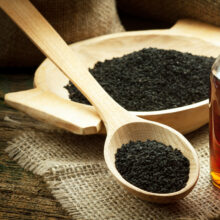The Skinny on Eating with the Seasons + 5 Foods to Help Your Body Thrive this Winter
- Published: Wednesday, January 16th 2013
- in Nutrition
By Rachel Chemerynski
Simply put, eating with the seasons is not only practical, but it’s also good for our wellbeing.
When you think about it, the seasons play a generous role in our everyday lives. From scheduling the annual holiday cocktail party to planning a vacay (hello spring break!), stocking up on SPF 50 for beach week to carving pumpkins in October, our decisions are undoubtedly impacted by the seasons.
However, when it comes to our eating habits, it seems we throw all of those principles out the door. While we’d never schedule a picnic with our sweetie in the middle of winter, many of us wouldn’t think twice before stocking up on berries or watermelon in January—but is this really the best choice for our health?
According to Ayurvedic medicine, we should be filling up on foods that are naturally harvested that season, the way nature intended us to eat.
In fact, eating with the seasons can maximize strength, energy, focus, and overall health, while also aligning with our innate desires, according to the book The 3 Season Diet, in which Dr. John Douillard suggests eating according to the three primary harvests: spring, summer, and fall/winter.
This explains why during the frigid, winter months we typically crave hearty soups, grains, and comfort foods, (think: homemade mac and cheese) and in the summer, our bodies beg for ice cream, berries, and other cooling eats.
 Alas, there’s a reason behind these crazy cravings after all! But, what are we to do about it?
Alas, there’s a reason behind these crazy cravings after all! But, what are we to do about it?
In his book The 3-Season Diet, Douillard writes:
“If you lived on a farm, you would naturally follow a 3-season diet, eating and craving the foods harvested with each of the three growing seasons. Now, so you are not restricted to eating only locally grown foods in season, foods from around the world are classified into one of the tree harvests. You can eat it all—just wait until it is in season.”
Since most of us don’t in fact live on a farm, let’s talk about what foods we can add to our grocery list now to start eating more seasonally this winter.
Fill your grocery cart with these five winter items:
1. Brussels Sprouts: These mini cabbage look-alikes are high in protein, fiber, vitamins, and powerful antioxidants, all working together to ward off health issues. One of the most common ways to prepare these little gems is by roasting them with salt, pepper, olive oil and garlic as a wholesome dinner side. Use leftovers to dress up salads, or as is for a quick and healthy snack. Be sure to chop off the rough ends before cooking if you buy in their whole form.
2. Avocados: Avocados seem to be on sale everywhere right now, and for good reason! This power fruit provides a generous amount of healthy fats, keeping us insulated throughout the cooler months. Make your own guacamole, whip up a kale and avocado salad or even add to your green smoothies for a creamier texture. If your avocados are rock-hard upon buying, try storing in a brown paper bag to speed up the ripening process.
3. Warming Spices: Forget hot cocoa and hand warmers! Spices like cumin, cardamom, ginger, and cinnamon are naturally warming, making them a must-have on your winter grocery list. Incorporate these spices into your morning oats, roasted veggies, smoothies, soups, and sauces throughout the winter months. As an added perk, cinnamon and cardamom naturally reduce cravings for sugar, a win-win in our book!
4. Quinoa: Whole grains help keep our bodies warm and satisfied, and are especially beneficial this time of year. We love quinoa (which is actually considered a seed) for its high protein levels and naturally gluten-free composition, making it easier to digest for most. Not to mention it’s a breeze to prepare and can be cooked in just 15 minutes. While most varieties are pre-rinsed, it’s always a good idea to rinse before eating to remove the outer naturally occurring toxic layer. Try adding to stir-fries, eating for breakfast as you would oatmeal (pairs nicely with nutmeg, agave and almond butter), or even using to make stuffed peppers!
5. Sweet Potatoes: This orange-colored veggie boats a heaping dose of antioxidants (including beta-carotene) and vitamins for the ultimate nutritional boost. Enjoy baked, mashed (try adding cinnamon or curry powder), or our favorite way–as sweet potato fries! To make sweet potato fries, simply slice potatoes into thin fry-shaped wedges, coat with olive oil, salt, pepper, and spices of choice and bake on 400 for about 30 minutes, or until slightly crispy.
Do you eat according to the seasons? What winter foods seem most appealing to you? Share your thoughts below, and stay tuned for more ideas on eating and living with the seasons!
You might also like:
Mirbeau Recipe: Salmon en Papillote with Jasmine Rice Timbale
Cleanse & Renew: 7 Detox Juice & Smoothie Recipes
8 Foods to Beat Anxiety & the Winter Blues & Blahs
Top 5 Healthy Eating Apps
Eat for Energy: 6 Easy-to-Eat Foods for Vigor & Vitality
Rachel Chemerynski is a certified health coach and freelance writer living in Boston, Massachusetts. She is the founder of Healthy Chicks, a wellness community dedicated to inspiring twenty-something women to live happier, healthier, more satisfying lives.



